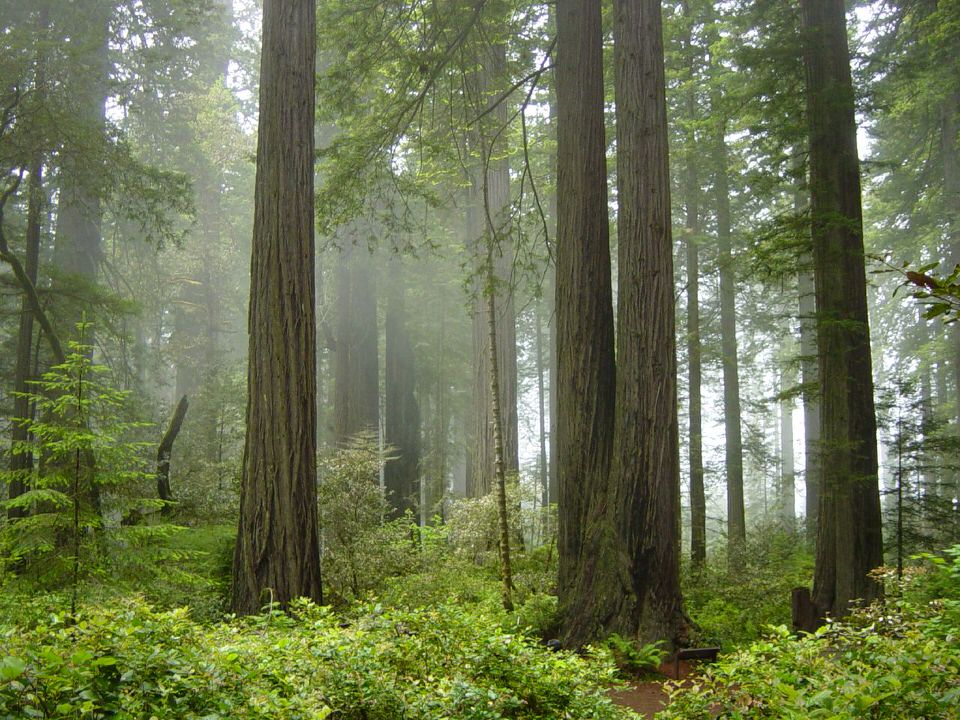
Redwood National Park
Redwood National and State Parks are home to some of the world’s tallest trees: old-growth coast redwoods. They can live to be 2000 years old and grow to over 300 feet tall. Spruce, hemlock, Douglas-fir, berry bushes, and sword ferns create a multiple canopied understory that towers over all visitors. The parks’ mosaic of habitats include prairie/oak woodlands, mighty rivers and streams, and 37 miles of pristine Pacific coastline. Cultural landscapes reflect American Indian history.
Here’s an excellent website to view this magnificent park.
The more recent logging history has led to much restoration of these parks. Three California state parks and the National Park Service unit represent a cooperative management effort of the National Park Service and California Department of Parks and Recreation. They are Prairie Creek Redwoods State Park, Del Norte Coast Redwoods State Park, Jedediah Smith Redwoods State Park, and Redwood National Park, comprising 45 percent of all the old-growth redwood forest remaining in California. Together these parks are a World Heritage Site and International Biosphere Reserve, protecting resources cherished by citizens of many nations. An amazing diversity of life exists at Redwood National and State Parks (RNSP). The ancient coast redwood ecosystem preserved in the parks contains some of the planet’s most majestic forests. Here, banana slugs, gray whales, Douglas-fir, black bears, and sea anemones are equally at home with redwoods. Park staff work to maintain and restore the area’s biological diversity through a wide range of resource management and educational activities. Preserving both natural processes and the region’s species and genetic diversity helps ensure that countless generations can experience the beauty and complexity of an old-growth redwood forest. Superlatives abound when a person tries to describe old-growth redwoods: immense, ancient, stately, mysterious, powerful. But the trees were not designed for easy assimilation into language. Their existence speaks for themselves, not in words, but rather in a soft-toned voice of patience and endurance. From a seed no bigger than one from a tomato, California’s coast redwood (Sequoia semperviren) may grow to a height of 367 feet (122 m) and have a width of 22 feet (7 m) at its base. Imagine a 35-story skyscraper in your city and you have an inkling of the trees’ ability to arouse humility. Some visitors envision dinosaurs rumbling through these forests in bygone eras. It turns out that this is a perfectly natural thought. Fossil records have shown that relatives of today’s coast redwoods thrived in the Jurassic Era 160 million years ago. And while the fantastic creatures of that age have long since disappeared, the redwoods continue to thrive, in the right environment. California’s North Coast provides the only such environment in the world. A combination of longitude, climate, and elevation limits the redwoods’ range to a few hundred coastal miles. The cool, moist air created by the Pacific Ocean keeps the trees continually damp, even during summer droughts. These conditions have existed for some time, as the redwoods go back 20 million years in their present range. Exactly why the redwoods grow so tall is a mystery. Theories continue to develop but proof remains elusive.The trees can reach ages of 2,000 years and regularly reach 600 years. Resistance to natural enemies such as insects and fire are built-in features of a coast redwood. Diseases are virtually unknown and insect damage insignificant thanks to the high tannin content of the wood. Thick bark and foliage that rests high above the ground provides protection from all but the hottest fires. The redwoods’ unusual ability to regenerate also aids in their survival as a species. They do not rely solely upon sexual reproduction, as many other trees must. New sprouts may come directly from a stump or downed tree’s root system as a clone. Basal burls, hard, knotty growths that form from dormant seedlings on a living tree, can sprout a new tree when the main trunk is damaged by fire, cutting, or toppling. Undoubtedly the most important environmental influence upon the coast redwood is its own biotic community. The complex soils on the forest floor contribute not only to the redwoods’ growth, but also to a verdant array of greenery, fungi, and other trees. A healthy redwood forest usually includes massive Douglas-firs, western hemlocks, tan oaks, madrones, and other trees. Among the ferns and leafy redwood sorrels, mosses and mushrooms help to regenerate the soils. And of course, the redwoods themselves eventually fall to the floor where they can be returned to the soil. The coast redwood environment recycles naturally: because the 100-plus inches of annual rainfall leaves the soil with few nutrients, the trees rely on each other, living and dead for their vital nutrients. The trees need to decay naturally to fully participate in this cycle, so when logging occurs, the natural recycling is interrupted. Use our vacation planner to be contacted by our renowned Virtuoso Travel Advisors, or just call: Travelwizard.com: Phone: 1 415 827 4981 or 1-415-446-5252 between 8:00 am and 5:00 Pacific Standard Time.



